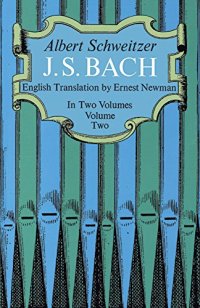
Ebook: J. S. Bach
Author: Albert Schweitzer
- Genre: Art // Music
- Tags: #Bach, #J.S. Bach, >> #JS Bach, #Albert Schweitzer, #J.S. Bach - Volume 2 - Schweitzer, #Schweitzer, #Music, #Biographies, #History & Criticism, #Instruments, #Musical Genres, Theory Composition & Performance, #Arts & Photography, #Biographies & Memoirs, #Arts & Literature, #Ethnic & National, #Historical, #Leaders & Notable People, #Memoirs, #Professionals & Academics, #Reference & Collections
- Year: 1967
- Publisher: Lowe and Brydone
- Edition: 0
- Language: English
- pdf
Independent of his international renown as a humanitarian, Albert Schweitzer is well known as a great musicologist; a reputation that rests largely upon this book. Schweitzer's J. S. Bach is one of the great full-length studies of the composer, his life, and his work. Its influence on the subsequent performance of Bach's music was enormous, and there is scarcely a later work on Bach which does not acknowledge a deep debt to Schweitzer's. Grove's Dictionary says of the book, "Schweitzer has probably been more quoted than any authority since Spitta."
The first volume contains a virtual history of Protestant church music, examining the role of music in the early Protestant services of many European countries. Frequent allusions to the parallel development of art and poetry, to the leading philosophic and religious concepts of the time, and to events of contemporary history supplement and enrich the text. Narrowing the study to Germany, Schweitzer traces to their roots the forms used by Bach (with particular emphasis on the German chorale and the forms built around it), and assess the contributions of Schütz, Sheidt, Buxtehude, Pachelbel, and others of Bach's predecessors. The volume includes a full account of Bach's life, and discusses his works for organ, clavier, strings, and orchestra. Suggestions for performance include sections on bowing, on playing chords and double stops, and on the practice of ornamentation in Bach's time.
Volume Two is concerned with Bach's choral music — the chorales, cantatas, the Magnificat, the St. Matthew and St. John Passions, the motets, songs, oratorios, and masses. The illuminating analysis of these works, illustrated by hundreds of musical examples, is dominated by Schweitzer's highly original theories regarding Bach's pictorial representation of the text in the music, and the expressive motives Schweitzer has found and identified throughout Bach's compositions. A long concluding chapter makes recommendations for performance on tempo, phrasing, accentuation, dynamics, and on the size and arrangement of the orchestra and choir.
Schweitzer's J. S. Bach is among the definitive reference works on Bach and is high on the list of required reading for music students. Yet it is not a difficult or formidable work. It offers a stimulating, well-written narrative, with much in it to interest the music lover as well as the scholar.
Independent of his international renown as a humanitarian, Albert Schweitzer is well known as a great musicologist; a reputation that rests largely upon this book. Schweitzer's J. S. Bach is one of the great full-length studies of the composer, his life, and his work. Its influence on the subsequent performance of Bach's music was enormous, and there is scarcely a later work on Bach which does not acknowledge a deep debt to Schweitzer's. Grove's Dictionary says of the book, "Schweitzer has probably been more quoted than any authority since Spitta."
The first volume contains a virtual history of Protestant church music, examining the role of music in the early Protestant services of many European countries. Frequent allusions to the parallel development of art and poetry, to the leading philosophic and religious concepts of the time, and to events of contemporary history supplement and enrich the text. Narrowing the study to Germany, Schweitzer traces to their roots the forms used by Bach (with particular emphasis on the German chorale and the forms built around it), and assess the contributions of Schütz, Sheidt, Buxtehude, Pachelbel, and others of Bach's predecessors. The volume includes a full account of Bach's life, and discusses his works for organ, clavier, strings, and orchestra. Suggestions for performance include sections on bowing, on playing chords and double stops, and on the practice of ornamentation in Bach's time.
Volume Two is concerned with Bach's choral music — the chorales, cantatas, the Magnificat, the St. Matthew and St. John Passions, the motets, songs, oratorios, and masses. The illuminating analysis of these works, illustrated by hundreds of musical examples, is dominated by Schweitzer's highly original theories regarding Bach's pictorial representation of the text in the music, and the expressive motives Schweitzer has found and identified throughout Bach's compositions. A long concluding chapter makes recommendations for performance on tempo, phrasing, accentuation, dynamics, and on the size and arrangement of the orchestra and choir.
Schweitzer's J. S. Bach is among the definitive reference works on Bach and is high on the list of required reading for music students. Yet it is not a difficult or formidable work. It offers a stimulating, well-written narrative, with much in it to interest the music lover as well as the scholar.